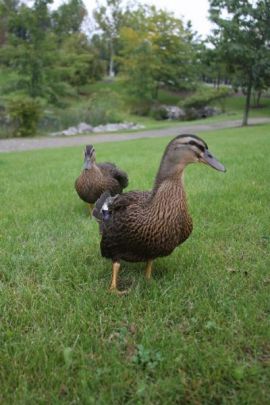Frank and Whiskey spend most of their mornings making their way from the Public Safety pond to the Roy H. Park School of Communications among groups of students and faculty. The journey is long for their little, webbed feet, but the rewards are plentiful as the bold pair approaches people, begging for breakfast.

With their human-friendly behavior, these two mallard ducks have gained a great deal of notoriety in a short amount of time.
Junior cinema and photography student Kristyne Fetsic, who began seeing the ducks this semester, said she already has an affinity for them.
“I’ve seen them outside just this year,” Fetsic said. “I call them Frank and Whiskey.”
Her name for the ducks would be more fitting if the two were male, but the lack of color on their heads and their overall muted coloring indicates that the two are, in fact, females.
Kit Straley, junior biology major, is especially interested in ducks and said she was shocked by the ducks’ interest in humans.
“One of the first days we were back … we were going to stop at Park, and they were just sitting outside,” Straley said. “I’ve always really liked ducks. I got really excited, and I slowly approached them, and then they just both stood up and ran over to us, which was a big surprise.”
This is the first semester these particular ducks have been seen by students. However, a pair of equally friendly ducklings were noticed this summer by junior psychology major Jacqueline Baum.
“I was here over the summer, and there were two baby ducks that were following everybody around,” Baum said. “We tried to leave them alone, and they kept following us around, so we had to wait ‘til they fell asleep, and then we ran away. We didn’t want to disrupt nature.”
Baum said she believes they are the same ducks because they make identical sounds and one of the ducklings had deformed wings, a trait shared with one of the Park School ducks.
“I assume they were the same ducks because they sound the same; they don’t really quack so well,” Baum said. “There’s one who has a wing stuck up in the back.”
In Straley’s close interaction with the ducks, she has observed the same deformity in the wings of one of the birds.
“Its wings were almost turned inside-out,” Straley said. “They fold out and up and stuck up like little spikes on its back, instead of [lying] down flat.”
Animal ecologist and assistant professor of biology Leann Kanda also observed the ducks and believes the malformation — and subsequently their inability to flee from humans — led students to start feeding one of the ducks. When the other noticed, it began begging for food as well.
“Since [the duck] couldn’t fly away when danger was approaching … basically it was stuck there,” Kanda says. “It started getting lots of attention. It started getting lots of food. And so its sibling said, ‘Hey, food.’”
To some it is very tempting to feed these cute animals. However, doing so is not in the ducks’ best interest. Straley said feeding bread to the ducks is not healthy.
“It’s bad for them,” she said. “Just like if you only ate bread.”
Sergeant Ronald Hart of Patrol and Security Services said he has responded to several complaints that the ducks, while not dangerous, are a bother.
“They don’t bite,” he said. “They can’t harm you. They’re more of a nuisance. We’ve had calls from people who’ve gone in [the building], and the ducks have walked in the building behind them.”
Kanda said the ducks’ comfort around people is more understandable given that they live on a college campus.
“Birds on campuses, [which are] very human-dominated landscapes, are always much more domesticated,” Kanda said. “They get used to humans being around that aren’t hurting them.”
Another reason not to feed the ducks is the hope that they might return to normal habits and participate in this fall’s migration. Straley said she noticed the deformed duck’s wings have been improving.
“Over time its [wings have] been sticking out a little bit less,” Straley said. “ I still can tell which one’s which because they act very different. But in terms of their wings, they now look exactly the same.”
This is positive news for all those who have become attached to the birds.
Straley said the ducks are becoming quite famous, starring in parts of several student projects.
“I took pictures of them for intermediate photography, and someone else used them for a CP class for a film called ‘Duck Films,’” Straley said. “They’re like celebrities.”
“I like them,” Baum said. “They’re kind of like the Park mascots now.”




